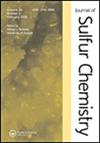Cleaner approach and antimicrobial screening of 2-selenoacetanilides: emergence of potential agents against co-infection
IF 1.6
3区 化学
Q3 CHEMISTRY, MULTIDISCIPLINARY
引用次数: 0
Abstract
Motivated to expand the investigation of the antimicrobial profile of 2-selenocetanilides and ebselen analogue, four compounds were prepared using a cleaner method in water as a solvent. Thus, 2-selenoacetanilides were obtained by the alkylation reaction of 2-chloroacetanilides with benzoyl (or phthalylglycyl) selenoate generated in situ under mild conditions. New compound 3a was submitted to single crystal X-ray diffraction, where only the Z-conformer was observed. In silico ADMET test was required to predicate the drug-like character of 2-selenoacetanilides, where, with exception of substituted 2-selenocetanilides that are probably mutagenic, all compounds predicted positive characteristics of lipophilicity, absorption, solubility and toxicity. Antimicrobial search for 2-selenoacetanilides was expanded, showing activity against 10 of 15 microorganisms tested, with MICs ≤ 80 µg.mL−1, including a medium pathogen (Cryptococcus gattii), high pathogens (Candida glabrata and C. tropicalis), a critical pathogen (Aspergillus fumigatus), in addition to Klebsiella pneumoniae, known as a superbug. The results indicate the emergence of compound 3a as a potential fungicidal against C. gattii, with MIC/MFC of 2.5 µg.mL−1, in comparison to the standard drug fluconazole, as well as compound 4c as a potential antimicrobial against K. pneumoniae and C. gattii, with MIC/MBC/MFC of 10 µg.mL−1, i.e. a new candidate to combat co-infection.
2-硒代乙酰苯胺的清洁方法和抗菌筛选:抗合并感染的潜在药物的出现
为了扩大对2-硒辛烷酰类化合物和依布硒类似物抗菌特性的研究,以水为溶剂,采用清洁法制备了4种化合物。因此,在温和条件下,2-氯乙酰苯胺与苯甲酰(或邻苯二甲酸乙酯)硒酸盐原位烷基化反应得到2-硒代乙酰苯胺。对新化合物3a进行单晶x射线衍射,只观察到z形构象。在硅中需要ADMET测试来预测2-硒代乙酰苯胺的药物样特性,其中,除了取代的2-硒代乙酰苯胺可能具有诱变性外,所有化合物都预测了亲脂性、吸收性、溶解度和毒性的阳性特性。扩大了2-硒乙酰苯胺的抗菌搜索,显示对15种微生物中的10种有活性,mic≤80µg。mL−1,包括中等病原体(加蒂隐球菌)、高致病菌(光念珠菌和热带假丝酵母)、临界病原体(烟曲霉),此外还有肺炎克雷伯菌,称为超级细菌。结果表明,化合物3a具有潜在的杀真菌活性,其MIC/MFC为2.5µg。mL−1,与标准药物氟康唑相比,以及化合物4c作为潜在的抗肺炎克雷伯菌和C.加蒂菌,MIC/MBC/MFC为10µg。mL−1,即抗共感染的新候选物。
本文章由计算机程序翻译,如有差异,请以英文原文为准。
求助全文
约1分钟内获得全文
求助全文
来源期刊

Journal of Sulfur Chemistry
CHEMISTRY, MULTIDISCIPLINARY-
CiteScore
4.10
自引率
9.10%
发文量
38
审稿时长
6-12 weeks
期刊介绍:
The Journal of Sulfur Chemistry is an international journal for the dissemination of scientific results in the rapidly expanding realm of sulfur chemistry. The journal publishes high quality reviews, full papers and communications in the following areas: organic and inorganic chemistry, industrial chemistry, materials and polymer chemistry, biological chemistry and interdisciplinary studies directly related to sulfur science.
Papers outlining theoretical, physical, mechanistic or synthetic studies pertaining to sulfur chemistry are welcome. Hence the target audience is made up of academic and industrial chemists with peripheral or focused interests in sulfur chemistry. Manuscripts that truly define the aims of the journal include, but are not limited to, those that offer: a) innovative use of sulfur reagents; b) new synthetic approaches to sulfur-containing biomolecules, materials or organic and organometallic compounds; c) theoretical and physical studies that facilitate the understanding of sulfur structure, bonding or reactivity; d) catalytic, selective, synthetically useful or noteworthy transformations of sulfur containing molecules; e) industrial applications of sulfur chemistry; f) unique sulfur atom or molecule involvement in interfacial phenomena; g) descriptions of solid phase or combinatorial methods involving sulfur containing substrates. Submissions pertaining to related atoms such as selenium and tellurium are also welcome. Articles offering routine heterocycle formation through established reactions of sulfur containing substrates are outside the scope of the journal.
 求助内容:
求助内容: 应助结果提醒方式:
应助结果提醒方式:


